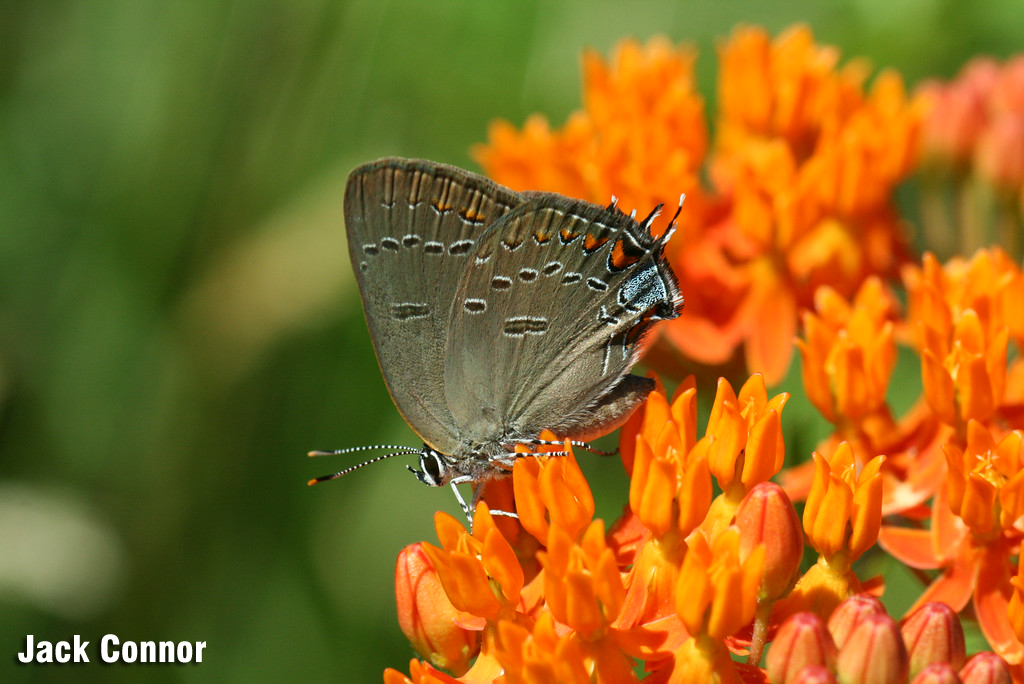Dr. Jack Connor, professor of Writing, and his wife, Jesse, caught a glimpse of blue flashing by a mimosa tree bursting with blooms. They tracked the streak through binoculars and watched it land on one of the pink puffs. The fluttering specimen proved to be a Pipevine Swallowtail butterfly (Battus philenor), a rarity in our region, which nectared on a flower for 15 minutes giving the Connors enough time to get a good enough look to identify the species.
“That was a thrill,” said Jack Connor, and one of the highlights of the Galloway Township 4th of July Butterfly Count for he and his wife who have participated in the annual species census for more than a decade. Although he wished he had his telephoto lens, Connor did capture a few macro shots from a distance. To see the photos, visit his Smugmug page.
They’ve sighted the Pipevine Swallowtail only once or twice in their years as official butterfly monitors.
The North American Butterfly Association (NABA) established a butterfly monitoring program to collect data through one-day counts on an annual basis to document distribution, fluctuations, and the effects of weather and habitat change on populations.
Dr. Jamie Cromartie, associate professor of Entomology and president of the American Entomological Society, organized the first Galloway Township 4th of July Butterfly Count, which includes parts of Stockton’s campus, in 1979.
On Saturday, July 5, the Connors “hopscotched” to sites in Port Republic, the Atlantic City airport, the field bordering AtlantiCare on Hackberry Way and Kennedy Farm on Stockton’s campus. They found 25 different species during this year’s count, a number that is “more than usual, but not the highest,” said Connor.
The total number of individuals they counted was 253, which is a number lower than average.
A cold winter coupled with a lingering spring resulted in later than normal flowering. Late-leafing delays a caterpillar which will feed on leaves before pupating and then emerging from its chrysalis.
The Connors are net-less butterfliers and use their cameras and binoculars as a window into the world of the winged wonders.
The Edwards’ Hairstreak is another state rarity they sighted during the count in two locations two miles apart. The scrub oak, which is very abundant on Stockton’s campus, is the Edwards’ Hairstreak’s host plant, yet, the species has never been seen on campus. Connor said that the Hairstreak depends on a specific ant species that has limited distribution, so both scrub oak and the ant are needed to support the Edwards’ Hairstreak.
Connor established the South Jersey Butterfly B/Log in 2008 while he was “deep into butterflies” (he still is) and “keeping track [of sightings] by telephone” with fellow butterfliers Will Curling, Pat Sutton, Steve Mason and others. The public spreadsheet, implemented through google documents, came first with the blog added shortly after to share stories and visuals. Other nature enthusiasts quickly tuned in.
There are tens of thousands of reports entered annually to the log with 15-20 very active contributors and another 15-20 who occasionally post sightings. Of the approximately 135 species found in New Jersey, 108 have been reported to the log, which covers the state’s southern eight counties.
This June, 70 species were reported on the log. The month saw lingering species in the early part and a few rarities towards the end.
“Butterflies are important ecological indicators – healthy habitats have them in the greatest variety – but they may be even more valuable as lures into the natural world. They are flashy, beautiful, and easy to ID. Once you learn a few, you want to see more and learn more about how they live. Searching for butterflies leads people outdoors and to a better appreciation for all that’s out there,” said Connor.
